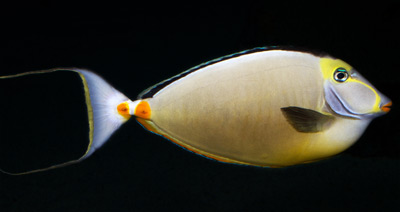Certain marine fish really make me wish I could afford to set up and maintain a much larger aquarium. Among these is Naso lituratus, the lipstick tang, aka the naso tang, tricolor tang, or orangespine unicornfish. Alas, this hardy, attractive Pacific species (according to Fishbase, the very similar Indian Ocean and Red Sea populations once regarded as N. lituratus are now classified as Naso elegans) gets much too big and is far too energetic for my 125-gallon FOWLR tank.
Physical traits
N. lituratus is characteristically tang-shaped with a laterally compressed, oval-shaped body and elongated snout. On each side of the caudal peduncle, it sports two razor-sharp, permanently erected spines that warrant very careful handling (they can get entangled in nets easily) as well as vigilance against accidental contact whenever working in the specimen’s tank. The caudal fin is lyre-shaped, with males developing long, trailing filaments that extend from the tip of each lobe. Maximum size for this species is around 18 inches.
Color-wise, these tangs can be quite variable depending on maturity, emotional state, and other factors, but in general terms, they’re some shade of gray to brown overall. The head above the eyes is yellow, and a black band edged in yellow extends from between the eyes down to the snout. The trailing edge of the caudal fin is yellow, the anal fin is orange with a blue margin, and the dorsal fin is black with a blue base and transparent margin. (In N. elegans, the dorsal is primarily yellow.) The lips are orange (thus one of its common names), and the caudal spines are highlighted in orange (thus one of its other common names).
Now, if you can find two specimens that fit this description exactly, you win the prize (breakfast at IHOP with “Caribbean Chris”)!
Feeding
Predominantly herbivorous and feeding primarily on brown algae in nature, N. lituratus should be offered a variety of algae-based foods in captivity. Dried marine algae sheets of various colors (Ocean Nutrition offers green, red, and brown algae in sheets), frozen herbivore formulations, New Life Spectrum pellets, and live macroalgae are all good options. Zooplankton also makes up a small portion of the lipstick tang’s diet, so occasional offerings of small meaty items are welcome as well.
Do note that N. lituratus is sometimes slow to accept aquarium fare. It’s very important to make sure your specimen is feeding—on proper herbivore foods, not just frozen brine shrimp—at your local fish store before buying!
Housing
As I indicated in my opening, N. lituratus needs a good-sized aquarium—around 200 gallons as a bare minimum. Plus, lipstick tangs are highly energetic and almost always on the move, so they need a lot of running room (Running lipstick? That’s right, I went there!) in addition to rockwork caves and crevices for hiding. The system should be aquascaped to allow unencumbered swimming—for example, by positioning the rocks in the center of the tank to allow a circular swimming pattern or arranging it in two bommies set away from the back and sides and with a space in between to create a figure-eight pattern.
Compatibility
Though generally peaceful toward other fishes, N. lituratus is likely to bicker with similar species, so conspecifics should not be kept together and I would caution against other tangs, particularly closely related species. Remember, those scalpel-like caudal spines mean business, so even a brief violent encounter can have serious consequences.
Is the lipstick tang reef safe? In the sense that it likely won’t bother sessile invertebrates, yes it is. However, it would need to be a very sizeable reef system indeed to cope with this big fish’s frenetic movement and copious waste production.



